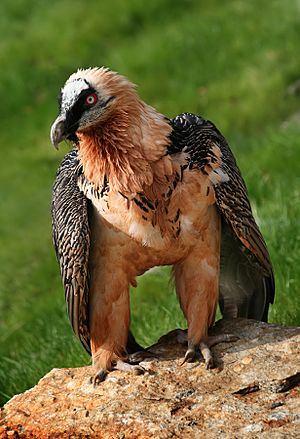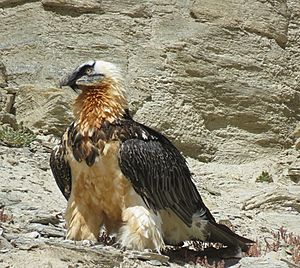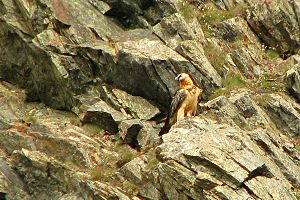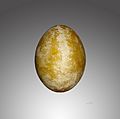Bearded vulture facts for kids
Quick facts for kids Bearded vulture |
|
|---|---|
 |
|
| Conservation status | |
| Scientific classification | |
| Kingdom: | |
| Class: | |
| Order: | |
| Family: | |
| Genus: |
Gypaetus
|
| Binomial name | |
| Gypaetus barbatus (Linnaeus, 1758)
|
|
The bearded vulture (Gypaetus barbatus), also known as the lammergeier, is a very unique bird of prey. It is the only type of bird in its group, called Gypaetus.
This vulture is different from most other vultures because it has feathers on its neck. It is related to the Egyptian vulture. Bearded vultures mainly eat carrion, which means dead animals. They live and raise their young in high mountains in places like southern Europe, Africa, and the Indian subcontinent. Females lay one or two eggs in winter. The young birds hatch in early spring. These birds usually stay in the same area all year round.
Contents
Description
This large bird is about 94 to 125 centimeters (37 to 49 inches) long. Its wingspan can reach 2.31 to 2.83 meters (7.6 to 9.3 feet). It weighs between 4.5 and 7.8 kilograms (9.9 to 17.2 pounds). Females are usually a little bigger than males.
It's easy to spot a bearded vulture flying. It has long, narrow wings and a long, wedge-shaped tail. Its body shape is often compared to a falcon, but much larger. Unlike most vultures, the bearded vulture does not have a bald head. It has a powerful, thick neck.
Adult bearded vultures are mostly dark gray, rusty, and whitish. Their upper body is gray-blue to gray-black. Their creamy-colored forehead stands out against a black band across their eyes. They also have black bristles under their chin, which look like a black beard. This "beard" gives the bird its name. The orange or rust color on their head and chest comes from dust-bathing or drinking in mineral-rich water. It's like they are putting on makeup! Young birds are dark black-brown. They take about five years to get their full adult colors. Bearded vultures are usually quiet. They make shrill whistles when they are breeding. They also make a falcon-like cheek-acheek sound near their nest.
Amazing Digestion
The bearded vulture has a very strong stomach acid. This acid can digest large bones in about 24 hours. Bones are full of fat, which gives the bird lots of energy. A skeleton left on a mountain can stay preserved for a long time. The bearded vulture can come back to eat the bones even months later.
Behaviour
Diet and Feeding
Like other vultures, the bearded vulture is a scavenger. This means it eats dead animals. But it's special because it mostly eats bones! About 85–90% of its diet is bone marrow. It's the only bird that specializes in eating marrow.
Bearded vultures can swallow small bones whole. They can also bite through brittle bones. For bones that are too big to swallow, they have a clever trick. They carry the bone high into the air, about 50 to 150 meters (160 to 490 feet) up. Then, they drop the bone onto rocks below. This smashes the bone into smaller pieces. Then they can get to the nutritious marrow inside. They can carry bones that weigh almost as much as they do!
After dropping a bone, the vulture flies down to check it. If the bone isn't broken enough, it will pick it up and drop it again. Young birds need a lot of practice to learn this skill. It can take them up to seven years to master it. This habit gave the bird its old name, ossifrage, which means "bone breaker." Sometimes, they try to break medium-sized bones by hitting them against rocks with their beak. During breeding season, they mostly eat carrion. They prefer limbs of sheep and other small animals. Unlike other vultures, they carry food back to the nest for their young.
Sometimes, bearded vultures will hunt live prey. They often go after tortoises. They drop tortoises from the sky to crack their hard shells. They have also been seen dropping other animals like rock hyraxes and hares. They might even attack larger animals like ibex or Chamois. They do this by surprising the animal and hitting it with their wings until it falls off a cliff. These usually happen if the animal is young, sick, or injured. There are old stories about them carrying off children, but these are not true. Biologists agree that if it ever happened, it would be a complete accident.
When looking for bones or prey, bearded vultures fly low over rocky ground. They usually stay about 2 to 4 meters (7 to 13 feet) high. Sometimes, a breeding pair will hunt together. In some areas, like the Ethiopian Highlands, bearded vultures have learned to eat human trash.
Breeding
Bearded vultures have very large territories. They might fly over two square kilometers (0.77 square miles) each day. The breeding season changes depending on where they live. It can be from December to September in Europe and Asia. In Africa, it can be year-round in some places.
Even though they are usually alone, a breeding pair is very close. Sometimes, one female might have more than one male partner. Their courtship display is amazing. They show their talons, tumble, and spiral through the sky. They even lock feet with each other and fall a distance before letting go!
Their nest is a huge pile of sticks. It can start about 1 meter (3.3 feet) across and 69 centimeters (2.3 feet) deep. After many uses, it can grow to 2.5 meters (8.2 feet) across and 1 meter (3.3 feet) deep. They cover the nest with animal remains from their food. The female usually lays 1 or 2 eggs. These eggs hatch after about 53 to 60 days. The young birds stay in the nest for 100 to 130 days before they can fly. They might depend on their parents for up to two years. This means the parents often nest every other year. Bearded vultures usually build their nests in caves or on ledges on steep rock walls. This makes it very hard for other animals to reach their young. In the wild, bearded vultures live for about 21 years. In zoos, they can live for at least 45 years.
Conservation Status

The bearded vulture is considered "Near Threatened." This means their numbers are decreasing, but they are not yet in immediate danger of disappearing. They naturally live in small groups. In Europe and Asia, there are only about a dozen to 500 pairs in each mountain range. The largest number of these birds live in Ethiopia. There, about 1,400 to 2,200 pairs are thought to breed. Some parts of the Himalayas also have healthy numbers.
In Europe, most bearded vultures were wiped out by the early 1900s. People used to hunt them because they wrongly feared that these birds would carry off children and farm animals. This was not true. They were also hunted for trophies.
However, bearded vultures have been successfully brought back to some areas. They are now living again in the Pyrenees mountains in Spain and the Alps in Switzerland and Italy. Their numbers have also gone down in parts of Asia and Africa, but not as much as in Europe. Today, their biggest threats are poisons left for other animals, loss of their habitat, people disturbing their nests, less food, and hitting power lines. Even with these problems, the bearded vulture lives in a very large area. Because of this, it is listed as Near Threatened on the IUCN Red List since 2014. There are probably fewer than 10,000 pairs left in the wild around the world.
Images for kids
-
A bearded vulture flying over Gran Paradiso National Park, Italy
See also
 In Spanish: Quebrantahuesos para niños
In Spanish: Quebrantahuesos para niños












